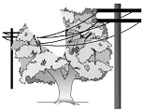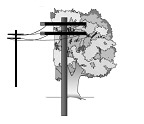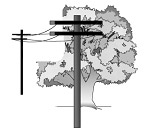Trees & Powerlines
Trees & Power Lines Don’t Mix
We depend on the benefits made possible by safe, reliable electricity. We also value the benefits of a very important natural resource – trees. Unfortunately, trees that grow too close to electric power lines threaten public safety and your source of power. For this reason, BrightRidge maintains a tree trimming and tree removal program.
Much of BrightRidge’s tree trimming is contracted to Kendall Vegetation Services. Maintaining proper line clearance is essential in maintaining reliable electric service.
Trees Must Be Planted A Safe Distance From Power Lines
BrightRidge follows the American National Standards Institute (ANSI) which requires a minimum of 10 feet of clearance surrounding overhead power distribution lines and up to 50 feet of clearance surrounding overhead power transmission lines. This safety zone is intended to prevent power line and tree conflicts which are costly, dangerous and cause service interruptions. Large tree varieties require the greatest distance from power lines. Recommended distances are as follows:
- Distribution lines: 25′ minimum
- Transmission lines: 50′ minimum
No trees of any size shall be planted directly underneath electric power lines. This is to ensure that BrightRidge crews can safely access power lines for service, maintenance, and emergency situations. Any trees planted directly underneath power lines are subject to removal without compensation to the owner.
It is your responsibility to maintain proper clearance from the last pole to your house. Help us keep the power on
Customer Tree Responsibility
Our goal is to provide dependable, reliable electric service to all customers. Trees that grow too close to primary and secondary power lines have the potential to threaten public safety and your source of power. It is important that BrightRidge and its customers work together to maintain proper line clearance.
BrightRidge assumes responsibility for maintaining proper clearance around its substations and most electric utility lines. It is the customer’s responsibility to maintain proper clearance from the last pole to their house, referred to as the service drop. BrightRidge determines when trees in the primary and secondary lines need to be removed or trimmed. The diagram below clearly defines each entity’s trimming responsibilities.
BrightRidge will provide cut-loose service to customers for the purpose of de-energizing the lines so that customer-owned trees in the service drop area may be removed or trimmed. This service is available at no charge provided the cut-loose request is made during these times: Monday – Friday, 8am to 3pm. You will be billed for cut-loose service provided beyond these times.
If you would like to schedule cut-loose service, please call the BrightRidge Service Department at 423-952-5025 during normal business hours (Monday – Friday, 8am to 5pm). All cut-loose service requests must be made five (5) business days prior and BrightRidge will try to accommodate requests based upon schedules. BrightRidge reserves the right to reschedule the request in the event of inclement weather, storm repair, power interruptions, and other unforeseen circumstances.
Long-Term Solutions
Before you invest in a tree that will grow tall, look around the area where you intend to plant. Carefully match the tree species with the location. Trees with mature heights over 25 feet should be planted at least 25 feet from any overhead utility lines.
The reliability of your neighborhoods’ electric service may depend on your choice of trees and where you plant them. Your cooperation with BrightRidge’s Right-of-Way Program is essential. Reliable service, public safety, and customer satisfaction are very important to us as your power provider. We will not trim or remove any tree unless it poses a threat to either public safety or electric service reliability.
Tips for Planting
Maturity Height vs. Minimum Space
| Tree size (Fully Mature) | Minimum spacing power line |
|---|---|
| Up to 20 feet | 20 to 25 feet |
| 20 to 40 feet | 30 to 35 feet |
| 40 feet and up | 40 to 45 feet |
BrightRidge recommends that you not plant any trees under power lines. Even small trees sometimes interfere and prevent crews from being able to easily access areas that require maintenance; however, the following list of trees are recommended if you decide to plant under overhead power lines:
| Tree Name | Mature Height |
|---|---|
| Acer Griseum-Paperbark | 18 – 25’ |
| Acer Ginnala-Amur Maple | 15 – 18’ |
| Acer Palmatium-Japanese Maple | 12 – 15’ to 25’ |
| Amalanchier-Serviceberry | 20 – 25’ |
| Cercis Canadensis-Eastern Redbud | 20 – 25’ |
| Cercis Canadensis-Forest Pansy | 18 – 24’ |
| Cornus Florida-Flowering Dogwood | 18 – 20’ |
| Magnolia-Little Gem | 20 – 25’ |
| Magnolia-Timeless Beauty | 15 – 20’ |
| Magnolia Soulangiana-Saucer | 15 – 25’ |
| Magnolia Virginiana-Sweetbay | 15 – 20’ |
| Magnolia Stellata-Star | 15 – 25’ |
| Malus Prairefire-Flowering Crabapple other varities-Indian Magic, Profusion Zumi, Red Splendor | 15 – 20’ |
Planting Tips & Maintenance
Look up: Are power lines overhead?
Never plant trees directly under power lines. Be sure to verify the maturity height of the tree you are planting as well as recommended minimum spacing requirements away from power lines.
Look down: Are there power lines underground?
Call before you dig. Your safety is of utmost importance. Call TN-One to locate underground utility lines before you dig. Plant trees and shrubs at least three feet away from underground power lines.
Look around: Do you see a green metal box in your yard?
If you see a green box in your yard, it could be a BrightRidge transformer, pedestal, or switch enclosure. NEVER plant trees or shrubs in front of the transformer doors. NEVER use probes to water or fertilize shrubs around transformers. If you decide to plant around the transformer box, consider mature plant size and always maintain a minimum three-foot clearance from all sides of the transformer. Once again, remember to call before you dig. Never begin digging without having underground power lines identified by the experts at TN-One Call.
Plant for Energy Efficiency
Properly Planted Trees Save Money
We are committed to encouraging customers to use energy efficiently. One of the greatest opportunities we have to conserve energy is by planting trees. Properly planted trees can stop cold winds, provide cool shade, and reduce energy usage year-round.
Remember: A properly planted tree is also one that is planted adequate distance away from power lines, meters, and transformers. Proper planting can also reduce the cost of tree trimming and tree removal required for maintaining proper safety of power lines, utility equipment, and right-of-ways.
Look up before you plant! Trees planted improperly jeopardize safety and your source for power.
Seasonal Tips for Efficiency
The right combination of trees and shrubs can provide a natural screen that protects your home from wind, noise, and dust. For energy efficiency in the winter, plant rows of shrubs and evergreens on the NORTH and WEST sides of your home. Pine, spruce, and hemlock make excellent windbreaks. Privet, yews, and hollies make good screens. *Check for minimum spacing from power lines before planting.
Shade trees can reduce summer energy costs. Deciduous trees (those that shed leaves in fall/winter) can provide summer shade and allow solar heat to filter through in winter. Planting deciduous trees on the EAST and SOUTHEAST sides of your home will provide shade during summer months during early-to-mid-morning hours. If your home receives a lot of hot afternoon sunlight, plant deciduous shade trees on the SOUTHWEST side of your home.
Low trees and shrubs planted close to your home reduce wind currents and create neutral air space which reduces winter heat loss and buffers your home from hot air in the summer.
Plant deciduous shade trees near your heat pump to reduce summer cooling costs. Doing so may also extend the life of your actual heat pump unit.
Proper Trimming Style
The old method of tree topping is no longer recommended by horticulturists and other professionals in the field, such as the National Arbor Day Foundation, The International Society of Arboriculture, and the National Arborist Association. Tree topping or rounding over can lead to decay, disease, insects, fungi, and may threaten the life of the tree. Weakened trees are more likely to break during wind, ice, and snowstorms.
Lateral, or natural trimming is the method used by line crews in most utilities. Lateral trimming is utilized by BrightRidge. The name lateral is derived from the method of cutting branches back to natural strong points on the tree, such as the juncture of the trunk and major limbs. Re-growth occurs with lateral trimming; however, branches tend to grow away from power lines and profuse sprouting of new limbs into power lines is avoided.
Pruning Methods

“V” Pruning “V” pruning is used for fast growing trees located directly under power lines when removal or crown reduction is not an option. No branches are left hanging over the lines with V pruning.

Side Pruning Side pruning involves pruning branches growing toward power lines on one side of the tree only. Any tree with a base located 15 feet or more away from the center line of BrightRidge conductors will be side pruned.

“L” Pruning “L” pruning is practiced when tree limbs cannot be pruned to a suitable lateral. This method of pruning involves pruning the branches which grow toward power lines on one side of the tree only.
Resources
Class Resources
Looking for resources for your gardening class or Arbor Day event? Use the link below to download an BrightRidge educational flyer about powerlines and tree safety.
Tree Flyer for EventsTree Line USA
BrightRidge is proud to be a Tree Line USA utility. Learn how that benefits your community at the link below.
Tree Line USAHave more tree questions?
Send in your tree questions by emailing contactus@brightridge.com